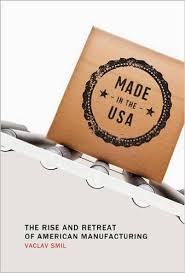Manufacturing Matters
 My maternal grandfather worked metal and wood. A talented craftsman, metalworking got him through the Great Depression, helped further his education (correspondence courses), allowed him to open a metal shop, and gave him a path to move up the economic ladder. By the end of his career he was an executive at a large company. Making it possible were the skills he gained from working in manufacturing.
My maternal grandfather worked metal and wood. A talented craftsman, metalworking got him through the Great Depression, helped further his education (correspondence courses), allowed him to open a metal shop, and gave him a path to move up the economic ladder. By the end of his career he was an executive at a large company. Making it possible were the skills he gained from working in manufacturing.
As I child, I was fascinated with his basement workshop. He showed me how to use tools and explained their function. There’s something immediate and magical about fixing things and making something useful. Early on, I connected making things with making money. Later on I learned through history that manufacturing is at the very core of America’s economic development.
Examining what American manufacture makes today is complicated. The US economy is enormous. Many companies and industries make things in the United States. On the other hand, we regularly read about the loss of industry, loss of jobs, loss of factories, and loss of know-how. Globalization and free trade can drive manufacturing to other countries. These are real changes with significant consequences. Some experts sound caution and others describe the US as a “post-industrial” country.
Getting a better handle on this issue drew me to Made in the USA: The Rise and Retreat of American Manufacturing by Vaclav Smil, one of Bill Gates’s favorite authors. Smil is a clear communicator who hits the reader like a drop forge. He writes of facts and data, giving the reader a ton of information – almost like a textbook or a briefing. Smil’s argument is clear, compelling and supported by facts: a prosperous economy needs a vibrant manufacturing sector and its jobs.
He explains that manufacturing has been and remains a significant component of the US economy. One statistic makes this clear. In 2010, the US manufacturing sector on its own was the seventh largest economy in the world, just behind Brazil. Smil also explains the many ways that manufacturing has a multiplier effect on other parts of the economy. It creates jobs, wealth, organizations, and “useful knowledge.” In other words, manufacturing matters a great deal.
Smil provides an excellent history of US manufacturing. His focus is mostly on business statistics and less of governmental macroeconomic policy until he reaches the 1970s. That chapter is titled “The Retreat” and it describes how multiple factors, from innovations in transportation to foreign policy to politics to technology combined to weaken US manufacturing. Smil believes that specific choices had a real impact on the vibrancy of American manufacturing. We are living today with the results of those decisions.
The last chapter of the book outlines opportunities and challenges for the future of US manufacturing. Smil is no idealist. Nor is he nostalgic for an earlier time. His perspective is about the bottom line: what decisions will maximize profit and what political and economic environments will lead to what choices? He is not optimistic about the return of mass manufacturing in America. He takes pains to draw distinctions between more manufacturing and more jobs. Nonetheless, he argues that if we want to keep the American economy strong, we have to find ways to support manufacturing.
It is an informative, thought-provoking book. And even though it is filled with facts, it leaves the reader with many questions.
David Potash